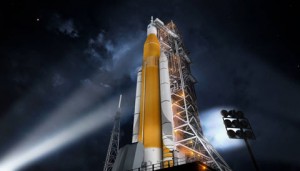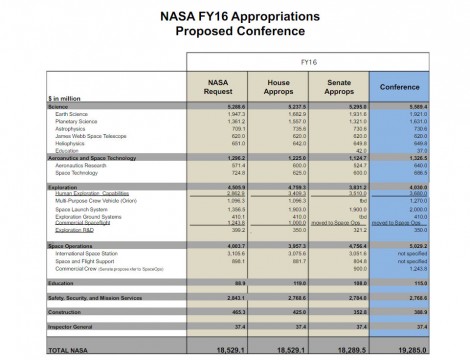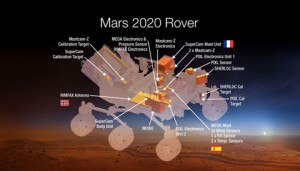An unexpected omnibus spending package for fiscal year 2016 increases NASA's funding.

NASA / MSFC
Space fans have a reason to cheer this New Year's Eve, as NASA is set to receive a big financial boost.
A bill passed through Congress earlier this month that would fund NASA to the tune of $19.3 billion dollars for the fiscal year 2016, almost $1.3 billion dollars more than the agency received in 2015, and $750 million dollars over what the agency had requested. The House of Representatives and the Senate have passed the $1.8 trillion package, and President Obama signed the measure shortly before Christmas.
The omnibus bill combines 12 individual pieces of legislation covering virtually every facet of government funding not tied to health care or Social Security. It’s considered “must-pass” legislation — in other words, a failure to pass the bill would trigger yet another government shutdown.
Surprisingly — considering the budget standoffs of recent years — the omnibus proposal sailed through Congress relatively unopposed, passing in the House at 316 to 113 and the Senate at 65 to 33.
“Lots (of lots) of reasons to celebrate,” tweets Planetary Society director Bill Nye, referring to the best budget for planetary sciences in 10 years.
Big Winners

Bill Adkins / The Planetary Society
"The best thing about this budget is that basically everything won," says Casey Drier (The Planetary Society). The FY2016 funding is the largest yet for NASA this decade. The agency's budget peaked at nearly 4.5% of the total federal budget in the Apollo era of the late 1960s, before bottoming out at less than 0.5% in the past decade. However, the increase still falls short of the "Penny for NASA" many have hoped for: the percentage is still roughly 0.5% of the $3.525 trillion dollar total federal budget asked for by Congress for 2016.
The increase couldn't come at a better time, as the agency works to transition from the end of the Space Shuttle era in 2011 to the age of Orion and the Space Launch System.
There's always a bit of tension when it comes to crewed versus robotic missions. "But in terms of pure funding increases, the Space Launch System and the Planetary Science Division received some of the biggest increases for 2016," Drier adds.
The SLS initiative will build the next big generation of heavy-lift rockets to take astronauts beyond low-Earth orbit to a near-Earth asteroid and eventually to Mars in the 2030s. SLS will receive $2 billion in FY2016. The Orion spacecraft already had its first test flight in 2014, and we expect to see the first SLS test launch in November 2018. The first launch of a crewed Orion capsule is slated for as early as 2021.
The continuation of International Space Station (ISS) operations will receive more than $5 billion dollars in 2016 — more than $1 billion dollars over what NASA requested — and includes moving the commercial initiative for Boeing and SpaceX to develop crewed transport from Exploration to ISS operations.
“By working with American companies to get our astronauts to the ISS, NASA is able to focus on game-changing technologies, the Orion spacecraft and the Space Launch System (SLS) rocket that are geared toward getting astronauts to deep space,” NASA Administrator Charles Bolden says on his blog.
The James Webb Space Telescope — which nearly fell under the congressional ax in the proposed FY2012 budget — comes under the more than $5.5 billion dollar science package for NASA, and will receive the $620 million dollars NASA asked for in its earlier proposal.
Prospects for Planetary Exploration

NASA
But the most exciting prospects in the FY2016 budget come in the form of planetary exploration. "The Planetary Science Division has been struggling under budget cuts requested by the White House each year," Drier notes. But under the FY2016 budget, the division will receive more than $1.6 billion dollars, about a quarter of a billion more than asked for.
Although the 2016 launch of Mars InSight has been pushed back to 2018, this boost will allow missions such as the Lunar Reconnaissance Orbiter and the current Mars rovers Opportunity and Curiosity to stay in operation. The development of the Mars 2020 rover and Europa mission set for the early 2020s will also remain on track. In fact, the bill requires the development of a daring Europa lander as part of the package.
The restart of production of plutonium-238, vital to powering deep-space missions, is also fully funded under the 2016 planetary science budget to the tune of $15 billion dollars. NASA hasn't specified (for security reasons) their stockpile of plutonium-238, but it's dwindling. A case in point: NASA purchased the plutonium powering the Curiosity rover from the Russians. The plutonium shortage had threatened to darken our eyes to the outer solar system until NASA elected to restart the production pipeline in 2013.
It's rare to have good news when it comes to space exploration And all that money is invested back into research, development, and industries back here on good old Earth. Expect an exciting year of space exploration in 2016.
 1
1
Comments
Thomas-Norris
January 1, 2016 at 2:46 pm
This is great news. Happy New Year! I wonder if this will give a boost to the James Webb Space Telescope?
You must be logged in to post a comment.
You must be logged in to post a comment.